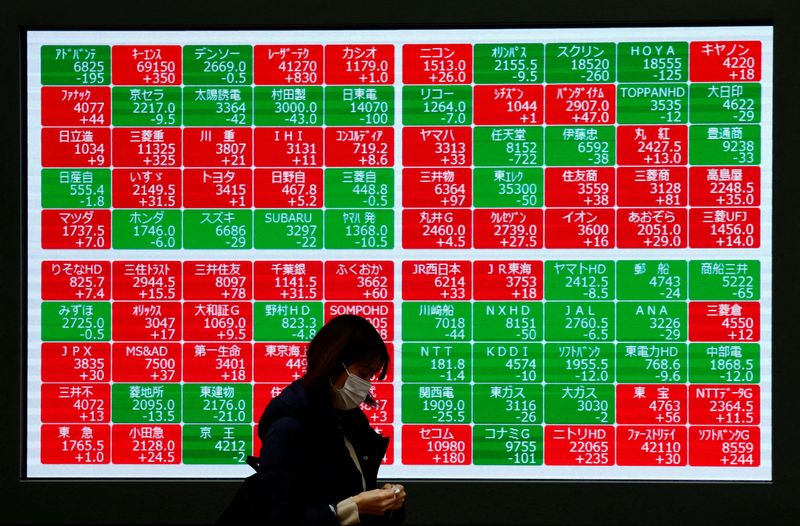Stocks, bonds tumble over global rates angst

Asian stocks were a sea of red on Thursday and bonds slid on bets global interest rates would stay higher for longer, as investors looked to key inflation readings at the end of the week for further clues on the future path of monetary policy.
The dollar rode U.S. Treasury yields higher while commodity prices came under pressure on renewed expectations that the Federal Reserve is unlikely to cut rates any time soon.
The latest halt in the global risk rally has come on the back of data pointing to lingering inflationary pressures across major economies.
“Hotter and stickier than expected global inflation appears to be taking the air out of asset markets,” said Vishnu Varathan, chief economist for Asia ex-Japan at Mizuho Bank. “Equities slid and bonds swooned, and USD swaggered.”
MSCI’s broadest index of Asia-Pacific shares outside Japan fell 1.2%, tracking a negative lead from Wall Street and extending its 1.6% decline from the previous session.

Japan’s Nikkei slumped 1.3%, while U.S. and European futures similarly fell. EUROSTOXX 50 futures eased 0.36% while S&P 500 futures declined 0.6%.
Nasdaq futures slid 0.7%.
A Fed survey on Wednesday showed U.S. economic activity continued to expand from early April through mid-May but firms grew more pessimistic about the future while inflation increased at a modest pace.
Across the Atlantic, data the same day showed German inflation rose slightly more than forecast to 2.8% in May, ahead of the wider euro zone bloc’s reading on Friday.
The main highlight of the week for markets, however, is Friday’s U.S. core personal consumption expenditures (PCE) price index report – the Federal Reserve’s preferred measure of inflation. Expectations are for it to hold steady on a monthly basis.
“If we look at data that has led us to this point, I have a hard time believing a softer-than-expected PCE report will arrive on Friday,” said Matt Simpson, senior market analyst at City Index.
“From this perspective, PCE not ticking higher could be a welcome surprise. But should it heat up further from sticky levels, appetite for risk will be taken out the back for a good kicking.”

U.S. Treasury yields meanwhile stayed elevated on Thursday, in part due to a weak debt auction the previous day. The benchmark 10-year yield was last at 4.6077%, while the two-year yield steadied at 4.9767%.
Bond yields move inversely to prices.
Japanese government bond (JGB) yields similarly notched fresh multi-year peaks, on growing expectations that further rate hikes from the Bank of Japan could be imminent.
The 10-year JGB yield peaked at 1.1% in early Asia trade, its highest since July 2011.
Elsewhere in Asia, Chinese blue chips eased 0.4%, tracking its regional peers despite the International Monetary Fund’s upgrade to China’s 2024 and 2025 GDP growth forecasts.
Hong Kong’s Hang Seng Index slid 1.4%.
DOLLAR REIGN
In the currency market, the dollar was on the front foot, knocking the euro to an over two-week low of $1.07915.
The yen last stood at 157.14 per dollar, after having slid to a four-week low of 157.715 in the previous session.
The Australian dollar fell 0.14% to $0.6601, after a brief lift in the previous session on data which showed domestic inflation unexpectedly picked up to a five-month high in April.
“This was not the inflation report the Reserve Bank of Australia would have wanted to see,” said Rob Carnell, ING’s regional head of research for Asia Pacific.
Oil prices lost ground on worries over weak U.S. gasoline demand and higher-for-longer interest rates.
Brent fell 0.18% $83.45 per barrel while U.S. crude ease 0.16% to $79.10 a barrel. [O/R]
Spot gold similarly fell 0.24% to $2,333.28 an ounce. [GOL/]